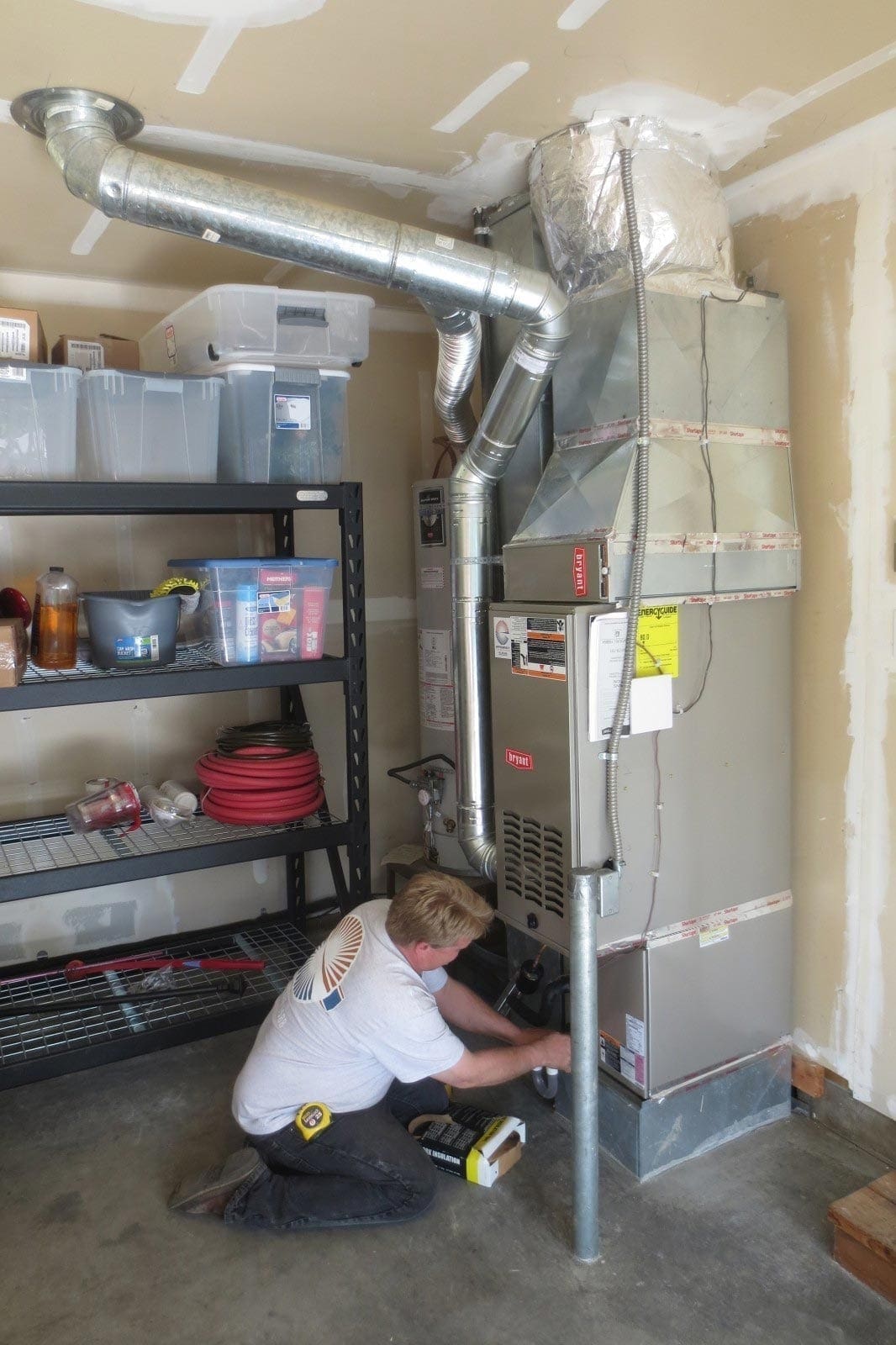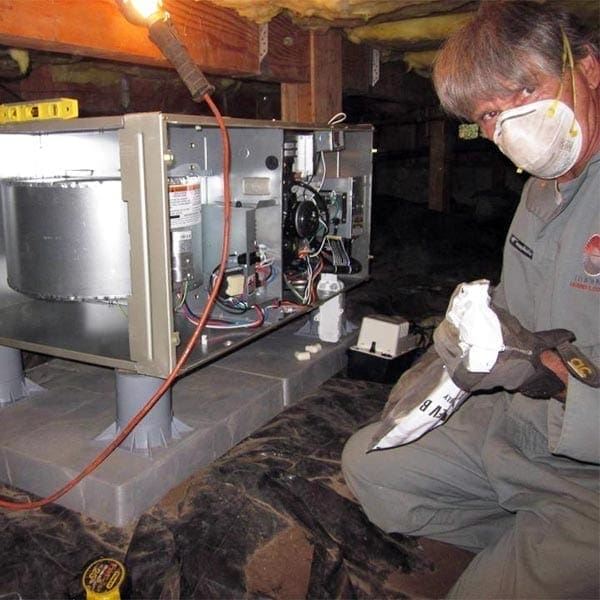Efficiency Heating & Cooling
Expert Portland Furnance Services
Efficient furnace service and local furnace maintenance are essential for keeping your heating system running smoothly. Trust Efficiency Heating & Cooling for all your furnace needs in the Portland Metro Area, from furnace installations and inspections to repair and cleaning.
Greater Portland Furnace Service for Home & Office
Explore our full range of furnace services, designed to enhance comfort and efficiency in both residential and commercial spaces. Whether you need routine maintenance, repairs, or a complete local furnace replacement in Portland, we’re here to help.
Contact us for emergency HVAC services or residential furnace services near you in Portland.
Real Reviews About Our Greater
Portland Furnace Solutions
FAQs about Furnace Repair and Maintenance
Q: What are common signs that my furnace needs repair?
A: Unusual noises, inconsistent heating, yellow pilot light, frequent cycling, a spike in energy bills, visible damage, water leaks, and burning or gas smells.
Q: How often should I schedule furnace maintenance?
A: At least once a year, ideally in the fall. We offer a special price of $69 for furnace tune-ups for a limited time!
Q: What is the average cost for furnace repair in Portland?
A: $150 to $650, but it can vary. We offer free estimates.
Q: Can I do DIY repairs on my furnace?
A: We strongly advise against attempting complex repairs yourself. It’s best to rely on a qualified HVAC technician.
Q: How can I improve my furnace’s energy efficiency?
A: Regular maintenance, change air filters, seal ductwork leaks, ensure proper insulation, consider a high-efficiency furnace, and use a programmable thermostat.
Q: What should I do if I smell gas near my furnace?
A: Evacuate your home immediately and contact your gas company and a qualified HVAC technician from a safe distance.
Q: What is involved in a professional furnace tune-up?
A: Inspection and cleaning of all major components, including burner assembly, heat exchanger, thermostat calibration, moving parts lubrication, electrical connections, venting system, airflow, temperature rise, safety controls, gas pressure and connections (for gas furnaces), and air filter change (if needed).
Q: Do you offer emergency furnace repair services?
A: Yes, we offer 24/7 emergency furnace repair services throughout the Greater Portland area.
Q: How long does a typical furnace last?
A: A well-maintained gas furnace can last 15-20 years, while an electric furnace may last 20-30 years.
Q: How much does a new furnace cost to install?
A: For a typical Portland-area home, expect to invest between $4,000 and $10,000 for a new gas furnace, including installation. We offer free estimates, financing options, and can help you determine what rebates you qualify for.
Schedule Your Local Furnace Service Today
Keep your home comfortable all year with our premium furnace services. At Efficiency Heating & Cooling, we specialize in expert heater and furnace installation, maintenance, and repair, tailored to meet your unique heating needs in Portland. Our skilled technicians are dedicated to delivering efficient and reliable solutions, ensuring your furnace operates at peak performance.
Don’t wait—schedule your furnace service today and experience the difference that professional care can make. Click the button below to book your appointment and let us take care of everything. If you’re unsure about what you need, don’t hesitate to contact us, and we’ll be happy to answer your questions.
We Offer HVAC Maintenance Plans
Learn about our affordable HVAC maintenance plans that prevent breakdowns and extend the lifespan of your system. Enjoy improved efficiency and reduced repair costs with routine expert upkeep.


One of the Best-Rated Furnace Companies in the Portland Area
Discover how Efficiency Heating & Cooling can help you save money with our advanced furnace technologies. Furnaces are essential for the Pacific Northwest’s cooler months, providing reliable and efficient heating to keep your home comfortable during the cold, damp winters.
Our modern furnace systems are designed to maximize efficiency, reduce energy consumption, and ensure consistent warmth throughout your home. Additionally, our furnaces contribute to a more sustainable living environment by optimizing energy use.
As a trusted local furnace company in the Portland metro area, we are committed to providing energy-efficient solutions that reduce your heating costs.
Contact us today to learn more about our services and start saving on your energy bills.
FAQs About Furnace Service
How often should I schedule furnace service?
Schedule furnace service annually to maintain efficiency and prevent breakdowns.
What is included in a furnace inspection?
A furnace inspection includes checking components, cleaning filters, and assessing safety.
How do I service my furnace myself?
Basic DIY maintenance includes: replacing air filters every 1-3 months, cleaning vents and registers, checking thermostat operation, and keeping the area around the furnace clean. More complex repairs should be left to professionals.
How much does it cost to check a furnace?
A professional furnace inspection typically costs between $80-150, though prices vary by location and service provider. Annual maintenance plans may offer lower per-visit costs.
Can I clean my own furnace?
Is furnace part of HVAC?
Yes, the furnace is a key component of an HVAC system. It handles the heating portion, while other components manage cooling and ventilation.
What does a furnace service include?
A typical furnace service includes inspecting the heat exchanger, cleaning burners and blower, checking electrical connections, testing safety controls, changing filters, and ensuring proper operation.
Why is duct cleaning important?
Duct cleaning improves air quality and enhances heating efficiency throughout your home.
How can I improve my home's air quality?
Improve air quality by regularly changing filters, cleaning ducts, and ensuring proper ventilation.
What are the benefits of a programmable thermostat?
A programmable thermostat helps optimize heating schedules, reducing energy costs and improving comfort.
More Information
The Importance of Regular Furnace Servicing
Regular furnace maintenance is key for keeping your home warm during chilly months. If you ignore it, you risk breakdowns, higher energy bills, and even safety problems. By investing in maintenance, you can enhance energy efficiency and enjoy a more comfortable living space.
Benefits of Regularly Servicing a Furnace
Getting routine furnace service brings many advantages that can help you save money and stay comfortable:
- Energy Efficiency: A well-maintained furnace runs more efficiently, resulting in lower energy bills. Regular checks catch issues early.
- Heating Repair Prevention: Preventive maintenance prevents emergency repairs by addressing minor problems before they escalate.
- Extended Lifespan: Consistent servicing helps your system last longer, saving you money on replacements.
- Certified Technicians: Skilled HVAC technicians know how to find problems that might be missed otherwise. Their expertise helps your furnace work its best.
By scheduling these services annually, homeowners can enjoy significant energy savings and reliable heating throughout the winter.
Signs You Need Furnace Service
Knowing when your furnace needs help is essential to avoid costly fixes. Look for these common signs:
- Emergency Repairs Needed: If your furnace suddenly fails or exhibits unusual behavior, such as turning on and off frequently, it’s time to have it inspected.
- Pilot Light Issues: A steady pilot light is a must. If it flickers or goes out frequently, there may be a problem with gas flow or venting.
- Unusual Noises from the Combustion Chamber: Sounds like banging or hissing could indicate mechanical issues inside that require immediate attention.
Being alert to these signs allows homeowners to take prompt action, preventing minor issues from escalating into costly repairs later on.
DIY Furnace Maintenance Tips for Homeowners
How to Perform Basic Air Filter Replacement
Regular furnace maintenance is crucial for keeping your system running efficiently and enhancing indoor air quality. One easy task you can do is replace the air filter. If the filter becomes clogged, it blocks airflow, causing your furnace to work harder and less efficiently.
Steps for Replacement:
- Turn off the furnace: Always turn off the power before starting any maintenance.
- Locate the filter: It’s typically situated in the blower compartment or where the return ducts connect to the unit.
- Remove and inspect: Remove the old filter and check for dirt buildup.
- Install a new one: Ensure you select a filter that fits properly and has a good MERV rating to maintain clean air.
Changing filters every 1-3 months helps save energy, extends equipment life, and keeps your home comfy.
Cleaning the Blower Compartment and Burner Flames
Keeping your furnace clean is crucial for maintaining efficient operation and extending its lifespan. Dust can accumulate in the blower compartment and around the burner flames, potentially causing heating issues.
Cleaning Steps:
- Carefully remove access panels after turning off the power.
- Use a soft brush or vacuum to clear dust from inside.
- Check the burner flames; they should be primarily blue with a slight yellow tint at the tips, indicating proper combustion.
Cleaning helps boost energy efficiency and reduces future heating repair needs by ensuring clear airflow paths.
Inspecting and Lubricating Moving Parts
To keep your HVAC system running smoothly, inspect moving parts such as motors, fans, belts, and bearings regularly. These parts can wear down without enough lubrication.
Inspection Checklist:
- Look for wear or damage on belts or pulleys.
- Listen for unusual noises that may indicate friction issues requiring attention.
Lubricate parts as recommended by the manufacturer using oils made for HVAC systems. Regular checks help avoid costly repairs from mechanical breakdowns later.
Checking Thermostat Calibration
A well-calibrated thermostat provides accurate temperature readings in your home—this is especially important during extreme weather conditions.
Calibration Steps:
- Use a reliable thermometer near the thermostat to compare readings.
- If there is a significant difference (over 2 degrees), follow the user manual to adjust it, or seek professional help if you are unsure.
Installing programmable thermostats can significantly boost energy savings by allowing you to control heating schedules according to your daily routine.
Regularly Inspecting Ductwork for Leaks or Blockages
Ductwork plays a vital role in distributing heated air throughout your home. However, leaks or blockages can reduce this effectiveness and raise utility bills!
Inspection Tips:
- Visually inspect accessible duct areas, especially joints, where gaps may develop over time due to aging or improper installation.
Seal any leaks found using mastic sealant to improve energy efficiency and maintain consistent warmth throughout all rooms connected to the duct system.
Scheduling Annual Furnace Inspections
Annual inspections are a smart preventive measure against unexpected breakdowns that may require emergency furnace repair. During these thorough assessments done by certified professionals:
- Technicians will thoroughly evaluate all systems, checking electrical connections and assessing functionality and safety protocols by local regulations, such as those in Portland, Oregon.
Taking proactive measures through annual inspections reduces risks associated with sudden failures, helping ensure everything runs smoothly year-round, regardless of outside temperature changes.
Professional HVAC Services in Portland, Oregon
Certified Furnace Technicians in Oregon
When your furnace needs help, certified HVAC technicians are key. They are trained to handle a wide range of heating systems. Their services include:
- Furnace Maintenance: Regular check-ups to avoid unexpected breakdowns.
- Heating Repair: Fast diagnosis and fixes for any issues.
- Residential HVAC Solutions: Customized services for homeowners to keep their systems running smoothly.
Choosing certified technicians ensures quality work and adherence to safety standards, providing you with peace of mind.
Affordable Emergency Furnace Repair Services
Furnace emergencies can strike at any time. If your heater fails, having affordable emergency furnace repair services is vital. Good providers offer:
- 24/7 Availability: Help when you need it most.
- Transparent Pricing: We provide precise cost estimates before repairs begin.
- Expertise with Gas and Oil Furnaces: Skilled technicians who are familiar with various fuel types provide effective solutions.
Affordable heating solutions mean comfort without high costs during emergencies.
Comprehensive Seasonal Checks by HVAC Professionals
Annual furnace inspections are crucial for maintaining your system’s efficiency. A seasonal check includes:
- Inspecting all parts for wear or damage.
- Cleaning filters and ducts for better airflow.
- Checking energy efficiency through detailed evaluations.
Preventative maintenance not only extends the life of your central heating system but also enhances performance and reduces energy costs over time.
Importance of Choosing Experienced Heating Contractors
Selecting experienced heating contractors is crucial for reliable service. Professional HVAC services ensure that every job is done correctly, saving you time and money on future repairs or replacements.
Look for contractors with positive customer reviews and a proven track record of providing reliable heating solutions tailored to individual needs.
Benefits of Regular Furnace Maintenance from Experts
Regular home furnace service offers many benefits, such as:
- Energy Savings: Efficient furnaces consume less energy, resulting in lower bills.
- Improved Indoor Air Quality: Regular duct cleaning helps reduce dust and allergens in your home, thereby enhancing the overall air quality.
- Extended Equipment Lifespan: Consistent upkeep prevents costly replacements by keeping systems running longer.
By prioritizing expert maintenance, homeowners enjoy better comfort throughout the year while protecting their investment in heating systems.
Customer Support and Consultation for Your Heating Needs
Strong customer support is crucial when choosing an HVAC provider. Look for companies that offer solid consultation options along with glowing customer reviews that reflect satisfaction guarantees.
You may also want to schedule a home energy audit, which provides insight into how effectively your current system operates compared to newer models, helping you make informed decisions about potential upgrades or changes needed in the future.
Energy-Efficient Solutions for Your Home Heating System
Energy efficiency matters today more than ever. As energy costs rise and environmental concerns intensify, homeowners must optimize their heating systems to reduce their impact on the environment.
High-efficiency furnaces not only cut utility bills but also help the planet. Upgrading your home heating system can lead to energy savings while keeping you comfortable during colder months.
To boost your home’s energy efficiency, focus on proper furnace installation and maintenance. Choosing the right residential HVAC system makes a significant difference in performance. High-efficiency furnaces utilize advanced technology to optimize fuel consumption, thereby reducing emissions and enhancing indoor air quality.
Exploring High-Efficiency Furnace Options
If you’re considering upgrading or replacing your heating system, it’s essential to explore energy-efficient furnace options. Many modern units use gas or oil as fuel, with high-efficiency models available.
- Energy-Efficient Gas Furnaces: These systems operate efficiently by using less gas than older models. They often feature modulating burners that adjust output based on demand.
- Oil Furnace Services: For homes with oil heat, newer oil furnaces feature improved combustion technologies that enhance efficiency levels.
- Forced Air Heating Systems: This system distributes warm air through ducts to various rooms effectively, providing comfort while minimizing wasted energy.
Consider replacing your furnace if it is over 15 years old or requires frequent repairs. A new high-efficiency model can reduce operational costs and increase reliability.
Enhancing Indoor Air Quality with Proper Maintenance
Maintaining good indoor air quality (IAQ) is closely tied to the efficiency of heating solutions. Regular maintenance is crucial for ensuring that your furnace operates efficiently and improves indoor air quality (IAQ) in your home.
Key practices include:
- Duct Cleaning: Dust and allergens build up in ductwork over time. Regular cleaning helps improve airflow and reduce the risk of respiratory problems.
- Carbon Monoxide Safety Checks: Installing and maintaining working carbon monoxide detectors protects against this hazardous gas, often associated with faulty heating systems.
- Regular Filter Changes: Changing filters every 1-3 months helps maintain optimal airflow while trapping pollutants.
By prioritizing these maintenance tasks, you create a safer environment while extending the life of your heating equipment.
Duct Sealing and Its Impact on Energy Savings
Duct sealing is crucial for achieving real energy savings in any home heating setup. Leaky ducts can waste up to 30% of heated air before it reaches living spaces, resulting in higher utility bills and insufficient warmth where it’s needed most.
Sealing ducts involves:
- Finding leaks using tools like smoke pencils or infrared cameras
- Using mastic sealant or metal tape at leak points
- Insulating exposed ductwork
Investing time in duct sealing boosts overall heating efficiency and improves comfort across various areas of the house, leading to lower monthly expenses due to reduced energy waste!
Troubleshooting Common Furnace Problems
Identifying Issues with Pilot Light or Ignition Control
A common problem for homeowners is dealing with pilot light issues or ignition control in gas furnaces.
If your furnace won’t start, the first step is to check if the pilot light is lit. If it’s flickering or out completely, there’s an issue. Possible causes include a dirty thermocouple that can’t detect heat properly or a blockage in the gas line.
If the ignition control is malfunctioning, it may be due to electrical issues, such as faulty wiring or a defective igniter switch. Here are some troubleshooting steps you can take:
- Check for Gas Supply: Make sure your gas valve is open.
- Inspect Components: Look at connections and clean any dirt from sensors.
- Professional Help: If these simple checks don’t work, consider seeking expert assistance.
Addressing Thermoregulation Concerns
Problems with your thermostat can affect how well your home heats up. If some rooms are too hot and others too cold, your thermostat may need adjustment or replacement. First, ensure it’s set to ‘heat’ mode.
Sometimes, heating system installation errors can result in inadequate temperature control throughout your home. To address this:
- Thermostat Installation: Place it away from drafts and sunlight.
- Adjust Settings: Small changes can improve how well it works.
- Get Expert Help: If installation mistakes are likely to occur, consult a professional specializing in residential HVAC systems.
Dealing with Unusual Noises from the Combustion Chamber
Hearing strange noises from your furnace can signal that something needs fixing.
Sounds like banging or squeaking may point to loose parts within the blower motor assembly that require attention.
To troubleshoot these noises:
- Identify Sounds: Notice if they happen when starting up or shutting down?
- Check the Blower Motor: Look for signs of wear and tear; lubrication may help reduce noise.
- Schedule Diagnostics: Regular furnace diagnostics can keep everything running smoothly.
Additional Common Furnace Issues to Consider
Furnace troubles can show up in different ways:
Furnace Won’t Start
If your furnace doesn’t start, check for power supply issues. First, inspect the circuit breakers and consider possible reasons, such as a faulty thermostat or blown fuses. This may need emergency furnace repair.
Inconsistent Heating Throughout the Home
If certain rooms remain chilly while others become too warm, duct sealing may be necessary to prevent air leaks and enhance comfort levels throughout the space—a standard solution available through professional assessments of home heating systems.
Frequent Cycling On and Off
When furnaces cycle frequently without providing consistent warmth (short-cycling), potential causes include incorrect energy efficiency ratings, which can cause systems to work harder than necessary. Regular preventative maintenance checks can identify inefficiencies early on, before they become costly repairs.
By being aware of early symptoms related to each area mentioned above—from pilot lights that won’t ignite to noises indicating possible mechanical problems—you put yourself in a better position to decide when a DIY fix is enough and when you might need trained experts for support.
Customer Reviews and Testimonials
Customer reviews matter when picking the best service for your home furnace.
At Efficiency Heating & Cooling, we specialize in delivering exceptional home furnace services. Our goal is to leave our customers satisfied and warm.
Real Experiences from Satisfied Customers
Our testimonials demonstrate the dedication of our certified HVAC technicians to providing exceptional residential HVAC solutions. Many clients share their positive stories about emergency furnace repair situations.
For example, one customer recalled how our team quickly arrived on a freezing night when their heating system broke down. The technician not only fixed the issue fast but also taught them ways to prevent future problems.
These stories help explain why so many homeowners trust us with their heating and repair needs. We are committed to delivering quality service, ensuring you receive reliable support whenever you need it.
Why Choose Efficiency Heating & Cooling?
When considering reliable furnace service, look for affordable heating solutions that offer good energy efficiency ratings and comprehensive maintenance plans. Here’s what we focus on:
- Reliable Furnace Service: Our skilled technicians can repair all types of furnaces, ensuring they operate efficiently and reliably.
- Affordable Heating Solutions: We offer competitive prices while prioritizing quality and safety.
- Energy Efficiency Ratings: Our systems help lower your energy bills while maintaining a comfortable home environment.
- Preventative Maintenance Plans: Regular check-ups can help your equipment last longer and function more efficiently.
Choosing us means you can relax knowing you’re partnering with a trusted company that cares about keeping your home warm and safe throughout the year.
Key Heating Services to Consider
- Heating System Installation: Expert installation ensures optimal performance and efficiency.
- Heat Pump Service: Regular maintenance maximizes heat pump efficiency for year-round comfort.
- Boiler Service: A professional boiler service ensures reliability and optimal energy efficiency.
- Gas Furnace Maintenance: Annual maintenance prevents costly repairs and keeps systems running smoothly.
- Oil Furnace Service: Specialized care for oil furnaces helps extend their lifespan and improve efficiency.
- Furnace Filter Replacement: Regularly replacing filters improves airflow and indoor air quality.
- Thermostat Adjustment: Proper adjustments ensure accurate temperature control in your home.
- Blower Motor Maintenance: Routine checks keep the blower motor functioning efficiently.
- Carbon Monoxide Safety Checks: Regular checks protect against carbon monoxide leaks from heating systems.
- Heating Efficiency Ratings: Understand ratings to choose energy-efficient models for your home.
- Duct Sealing: Sealing leaks in ducts improves heating performance and lowers energy bills.
- Home Energy Audit: A professional audit identifies ways to enhance overall heating efficiency.
- Preventive Maintenance Plans: These plans help manage routine inspections, prolonging system life.
By prioritizing these services, you ensure reliable heating solutions that enhance comfort throughout your home in Portland, Oregon, and surrounding areas like Beaverton, Tigard, Gresham, Hillsboro, Clackamas County, Multnomah County, and Washington County.
Not Seeing What You Need?
Contact Us For Customized Furnace
Help or Any HVAC Questions
Best Top Rated Furnaces & Brands in Portland



































